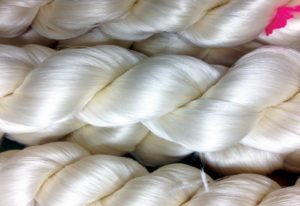
silk hanks from bioengineered silkworms. Photo: Kraig Biocraft Laboratories Inc.
Since the industrial revolution, textiles have transitioned from natural fibers of cotton, wool, silk and linen to textiles created from petroleum products and reconstituted wood pulp. Today’s synthetic fibers are stronger, cheaper to manufacture, and have proven easily adaptable to a wide range of technical, performance and smart textiles, to the benefit of modern life. Yet as a result, we are now awash with petroleum-based plastic waste and microfiber pollution, which—unlike natural and synthetic cellulosic fibers—does not biodegrade.
Alarm bells are ringing, inspiring textile scientists, engineers, designers and manufacturers to take a new look at natural fibers and what they have to offer beyond their innate comfort and good looks. Spinners and technology suppliers are collaborating to create natural fiber textiles and composites with unexpected qualities, and bioengineering is creating new strains of natural fibers with desirable properties. Perhaps even more exciting, textile engineers are finding ways to create conductive yarns and smart textiles utilizing natural fibers.
The superhero of yarns

“We’re a yarn company, making high-tech yarns for the last three decades,” says Matt Kolmes, CEO of N.C.-based Supreme Corp., which introduced its Volt Smart Yarns a little over a year ago. When a military defense contractor approached Supreme about creating a better smart yarn, Supreme’s covering equipment proved perfect for encapsulating flexible, conductive copper wire.
“The design of most smart yarns was primitive. We thought we could do better,” Kolmes explains. The result of the company’s efforts is a low-resistance, coaxial cable inside a sewing thread. “With sewing capability, we can put conductivity anywhere. Sewing thread is the superhero of yarns. The clothing is the technology.”
Volt’s conductive yarns and threads can be knit, woven or sewn into fabrics. The company has advanced its technology, going from two fine copper wires to sixteen within a single yarn.
Having received a number of requests to provide conductive yarns covered in natural fibers, Kolmes is enthusiastic about the potential for wool, cotton and silk smart yarns. Volt recently worked with Cotton USA to develop a high-tech winter coat with a conductive pocket capable of charging a mobile phone or generating heat.
Enhancing merino wool
With its inherent softness, breathability and moisture management qualities, merino wool has become the darling of outdoor enthusiasts. But while it’s ideal for base and mid-layer knitwear, the fiber lacks the strength and elasticity for more hard-core end uses. By marrying wool with nylon, spinners are creating high-performance, durable textile products. A favorite of the U.S. military, Cordura® Combat Wool™ has developed a portfolio of rugged knits and wovens using wool spun with Invista’s 6,6 high-tenacity nylon staple.
Showing up in outdoor apparel brands, such as Ortovox, KUIU and TREW, NuYarn® is a proprietary spinning technology developed in New Zealand and now owned by TMC (The Merino Company). Fabrics made of NuYarn’s blend of merino and nylon are touted to dry five times faster, offer 39 percent more bulk per weight, and exhibit improved burst strength and elasticity over standard merino fabrics.
Calif.-based Global Merino Inc.’s Rapt™ fabrics are created from a nylon core yarn that is encased in merino wool fibers. With a burst strength rating of 50 psi and above, the fabrics have been adopted by brands such as Smartwool®, Merona and Rafa.
“We are constantly looking at new ways to combine yarns and fibers,” says Jose Fernandez, Global Merino’s president. “One of the advantages of a blend like this is the possibility that a smart technology can be embedded into the synthetic master batch.”
The Woolmark Company, a subsidiary of Australian Wool Innovation, recently collaborated with China’s Nanshan Group to develop a 100 percent wool outerwear fabric that is wind and water resistant. Called Neulana Protect, the fabric is densely woven of merino yarns that are stretched but not set, using Woolmark’s proprietary Optim™ processing. When the textile is wet-set, the fibers contract and tighten the structure to create a weather-resistant fabric—without the use of synthetic fibers or DWR (durable water repellent) chemistry.
According to Woolmark communications director Julie Davies, “We are realizing various opportunities to pair wool with smart fibers and yarns to lend merino wool’s inherent benefits to the synthetic fibers, finishes and hardware hosting the technology.”
Re-engineering natural fibers
In Australia, CSIRO (The Commonwealth Scientific and Industrial Research Organisation), an independent agency of the federal government, works with farmers to breed cotton fibers that are suitable for today’s technologies. CSIRO scientists are developing “next generation cotton” fibers that exhibit benefits similar to those of synthetics, such as stretch, wrinkle-resistance or water repellency. Their research is part of CSIRO’s Synthetic Biology Future Science Platform, a $13 million investment in science that applies engineering principles to biology.
Kraig Biocraft Laboratories Inc., based in Ann Arbor, Mich., brings us bioengineered Dragon Silk™, currently undergoing ballistic testing to U.S. Army standards. Spun by genetically engineered silkworms, Dragon Silk is extremely strong and flexible, biocompatible and biodegradable. Kraig has developed its silkworms to work within the current methods of silk production and is in the process of building a production facility in Vietnam.
A biodegradable polymer synthesized from jute could soon be the antidote to the ubiquitous polyethylene bag. A Bangladeshi scientist, Dr. Mubarak Ahmad Khan, created the polymer from cellulose extracted from the jute fiber. With a similar texture to polyethylene bags, the jute polymer bags are stronger, yet decompose within three to four months in a landfill.
Building with linen and flax
There’s a growing appreciation for the environmental benefits and mechanical properties of linen and hemp in composites. In 2009, the European Confederation of Flax and Hemp (CELC) established its European Scientific Council to focus on innovation in these biocomposites for a wide range of industrial end uses. Renewable, biodegradable and recyclable, flax and hemp reinforcements exhibit lower density and higher stiffness than glass fiber, and better insulation and vibration damping than glass or carbon fiber.
Bio-based bridges are being constructed in the Netherlands, such as the 14-meter pedestrian bridge at Eindhoven University of Technology, built of polylactic acid (PLA), foam, cork, hemp and flax fibers, and a bio-based epoxy resin. The world’s largest biocomposite bridge, with a total length of 66 meters, is currently under construction across the Van Harinxma Kanaal near Ritsumasyl. The decks, created from 100 percent biocomposite, based on flax, with 80 percent bio-based resins, are expected to have a life span of 100 years.
The textile world is rediscovering the properties of natural fibers. Stronger, smarter and more adaptable than we ever expected, they can compete with synthetics in many end uses—and provide sustainable options for the future.
Debra Cobb is a Tennessee-based freelance writer with extensive experience in the textiles industry.
 TEXTILES.ORG
TEXTILES.ORG


